Search
Recent Posts
- Types of Speed Breakers: How to Choose the Right Solution for Every Road
- New Driver’s License Rules in India: A Quick Guide
- Top 15 Road Safety Equipment Items You Need to Know About
- Traffic Cone Colors Explained: What They Mean & Where to Use Them
- Enhancing Road Safety with Reflectors: A Comprehensive Guide
10 Important Road Safety Signs and What They Mean
Road safety signs are crucial for traffic control and preventing accidents. Understanding the meaning of various road signs is important for everyone, including new and experienced drivers.
This blog explains 10 important road signs, explaining their purpose and meaning to promote road safety and prevent deadly accidents. So, without any wait, let’s learn about them.
1. Pedestrian Crossing Sign
One of the most popular traffic signs, the pedestrian crossing sign ensures the safety of people crossing the road.
- Appearance: A triangular sign with a depiction of pedestrians walking across a striped path. In some cases, it may include text or arrows.
- Meaning: Alerts drivers to slow down and be prepared to stop if pedestrians are present. These crossings are usually marked by zebra stripes on the road.
- Purpose: To safeguard pedestrians and avoid accidents.
- Detailed Guidance: Pedestrian crossings are often located near schools, shopping centers, and busy intersections. Drivers are legally required to stop for pedestrians at these crossings, making them an essential part of urban road infrastructure. Additionally, pedestrians should always look both ways before stepping onto the crossing, ensuring their safety.
2. One-Way Traffic Sign
The one-way traffic sign is crucial for maintaining traffic flow and avoiding confusion in urban areas.
- Appearance: A rectangular or square sign with an arrow pointing in the designated direction. The words “One Way” may also be displayed.
- Meaning: Indicates that traffic is allowed to flow only in the direction shown by the arrow.
- Purpose: To manage traffic efficiently in areas where two-way traffic isn’t feasible.
- Detailed Guidance: One-way streets are common in city centers, where road width and heavy traffic demand unidirectional movement. Drivers must pay close attention to these signs to avoid traveling in the wrong direction, which could lead to collisions or fines.
3. Stop Sign
The stop sign is one of the most recognizable traffic signs globally and is essential for preventing collisions.
- Appearance: A red octagonal sign with the word “STOP” written in white capital letters.
- Meaning: Instructs drivers to come to a complete halt and check for other vehicles or pedestrians before proceeding.
- Purpose: To ensure that all road users get a chance to navigate intersections safely.
- Detailed Guidance: At a stop sign, drivers must come to a full stop behind the line marked on the road. Rolling stops are illegal and dangerous, as they increase the likelihood of accidents. Drivers should also be mindful of other vehicles that may have the right of way.
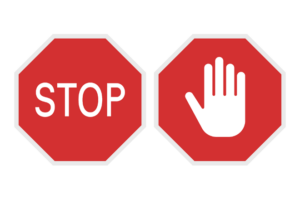
4. Railway Crossing Sign
This sign is crucial for alerting drivers about an upcoming railway crossing, reducing the risk of accidents.
- Appearance: A triangular or circular sign with a depiction of a train or tracks.
- Meaning: Warns drivers to slow down and check for approaching trains before crossing the tracks.
- Purpose: To prevent collisions between vehicles and trains.
- Detailed Guidance: Many railway crossings are equipped with barriers or flashing lights to enhance safety. However, drivers should always exercise caution, especially in areas with unguarded crossings. Never attempt to cross the tracks when a train is approaching, even if it seems far away.
5. Speed Limit Sign
Speed limit signs are important for regulating the speed of vehicles on different types of roads.
- Appearance: A circular sign with a number indicating the maximum allowed speed, often surrounded by a red border.
- Meaning: Specifies the maximum speed at which vehicles can travel on that particular stretch of road.
- Purpose: To reduce accidents caused by overspeeding and ensure smoother traffic flow.
- Detailed Guidance: Speed limits vary based on the type of road and its surroundings. For example, residential areas typically have lower speed limits than highways. Adhering to these limits helps drivers maintain control of their vehicles and respond to unexpected hazards more effectively.
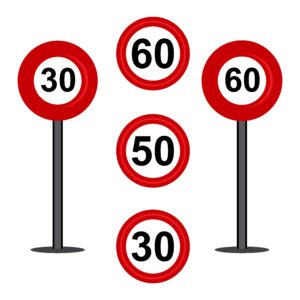
6. No Parking Sign
The no parking sign helps to regulate parking behavior in busy areas.
- Appearance: A circular sign with a red border and the letter “P” crossed out.
- Meaning: Indicates that parking is not allowed in the designated area.
- Purpose: To ensure unobstructed traffic flow and prevent congestion.
- Detailed Guidance: Parking in no-parking zones can lead to fines and vehicle towing. Drivers should always look for designated parking areas to avoid inconveniencing others and contributing to traffic jams.
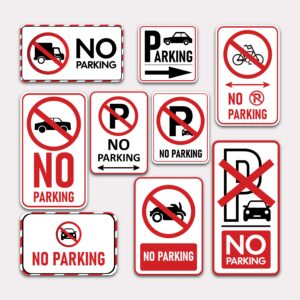
7. School Zone Sign
This school zone sign is essential for protecting children near schools.
- Appearance: A triangular sign with a depiction of children walking, often accompanied by the text “School Zone.”
- Meaning: Alerts drivers to slow down and be extra cautious as children may be crossing the road.
- Purpose: To create a safer environment for students and other pedestrians in school areas.
- Detailed Guidance: During school hours, roads near schools can be chaotic. Drivers should remain vigilant and obey crossing guards or additional signage that may be in place. Parents dropping off children should do so in designated areas to ensure safety.
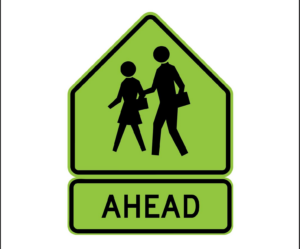
8. U-Turn Prohibited Sign
This sign prohibits drivers from taking a U-turn, preventing potential collisions.
- Appearance: A circular sign with a red border and a curved arrow crossed out.
- Meaning: Indicates that making a U-turn is not allowed at that location.
- Purpose: To maintain smooth traffic movement and prevent accidents.
- Detailed Guidance: Prohibited U-turn areas are typically located at busy intersections or narrow roads. Drivers should plan their routes in advance to avoid unnecessary turns that could lead to violations or dangerous situations.
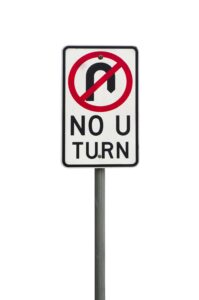
9. Give Way Sign
This sign ensures that drivers yield the right of way to others, promoting safer intersections.
- Appearance: An inverted triangular sign with the words “Give Way” or a simple outline with no text.
- Meaning: Drivers must slow down and let other vehicles or pedestrians pass before proceeding.
- Purpose: To minimize conflicts at intersections and enhance road safety.
- Detailed Guidance: Give way signs are often found at roundabouts and minor roads merging with main roads. Drivers should be patient and wait until the path is clear before moving forward.
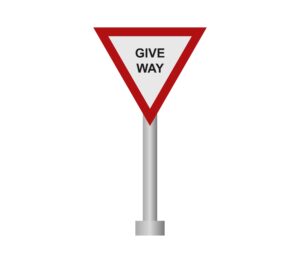
10. Slippery Road Sign
This sign warns drivers about potentially slippery road conditions, especially during rain or snow.
- Appearance: A triangular sign with a depiction of a car and wavy skid marks.
- Meaning: Advises drivers to reduce speed and exercise caution to avoid losing control.
- Purpose: To reduce the risk of accidents caused by slippery surfaces.
- Detailed Guidance: Drivers should pay attention to this sign during adverse weather conditions. Reducing speed and maintaining a safe distance from other vehicles are essential for avoiding accidents on slippery roads.

Additional Tips for Road Safety
- Always wear a seatbelt while driving or riding as a passenger.
- Follow traffic signals and never jump red lights.
- Avoid distractions such as using mobile phones while driving.
- Use timely indicators to signal your intentions to other drivers.
- Maintain your vehicle in good condition, especially brakes and tires.
Conclusion
Understanding road signs and their meanings is essential for every road user. These 10 important road signs, including the pedestrian crossing sign, one-way traffic sign, and railway crossing sign, play a significant role in ensuring road safety. By learning and respecting these signs, we contribute to a safer driving environment for everyone.
Whether you are a student, a new driver, or an experienced road user, always keep these signs in mind. They are not just symbols; they represent rules that save lives. Let’s prioritize road safety by understanding and obeying these vital traffic signs.

